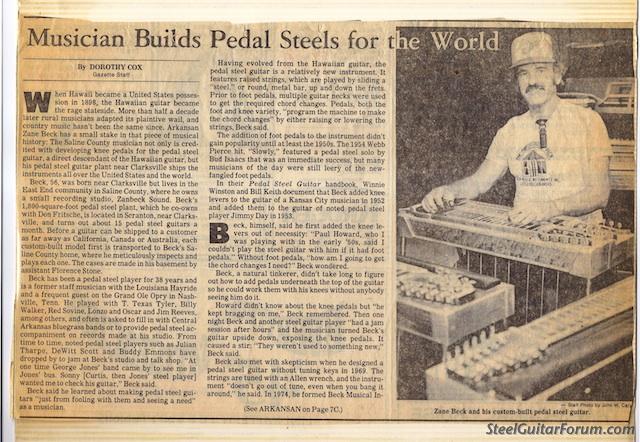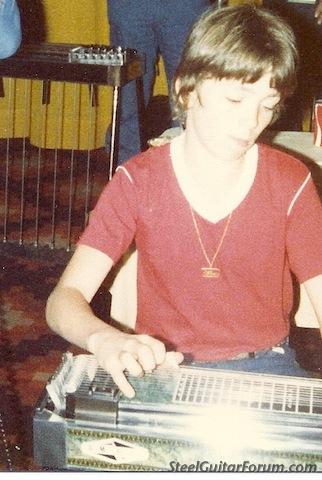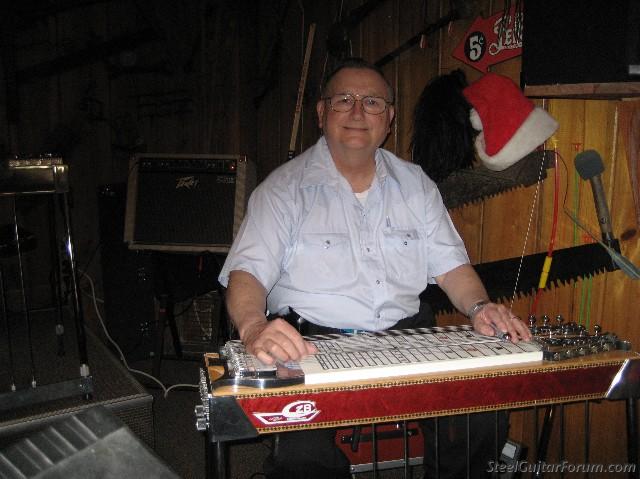

When Hawaii became a United States possession in 1898, the Hawaiian guitar became the rage stateside. More than half a decade later rural musicians adapted its plaintive wail, and country music hasn't been the same since. Arkansas Zane Beck has a small stake in that piece of musical history. the Saline County musician not only is credited with developing knee pedals for the pedal steel guitar, a direct descendant of the Hawaiian guitar, but his pedal steel guitar plant near Clarksville ships the instruments all over the United States and the world.
Beck, 56, was born near Clarksville but livs in the East End community in Saline County, where he owns a small recording studio, Zanbeck Sound. Beck's 1800-square foot pedal steel plant, which he co-owns with Don Fritsche, is located in Scranton, near Clarksville, and turns out about 15 pedal steel guitars a month. Before a guitar can be shipped to a customer as far away as California, Canada, or Australia, each custom-built model first is transported to Beck's Saline County home, where he meticulously inspects and plays each one. The cases are made in his basement by assistant Florence Stone.
Beck has been a pedal steel player for 38 years and is a former staff musician with the Louisiana Hayride and a frequent guest on the Grand Ole Opry in Nashville, Tenn. He played with T. Texas Tyler, Billy Walker, Red Sovine, Lonzo and Oscar and Jim Reeves, among others, and often is asked to fill in with Central Arkansas bluegrass bands or to provide pedal steel accompaniment on records made in his studio. From time to time, noted pedal steel players such as Julian Tharpe, DeWitt Scott and Buddy Emmons have dropped by to jam at Beck's studio and talk shop. "At one time George Jones' band came by to see me in Jones' bus. Sonny (Curtis, then Jones' steel player) wanted me to check his guitar," Beck said.
Beck said he learned about making pedal steel guitars "just from fooling with them and seeing a need" as a musician.
Having evolved from the Hawaiian guitar, the pedal steel guitar is a relatively new instrument. It features raised strings, which are played by sliding a "steel" or round, metal bar, up and down the frets. Prior to foot pedals, multiple guitar necks were used to get the required chord changes. Pedals, both the foot and knee variety, program the machine to make the chord changes" by either raising or lowering the strings, Beck said.
The addition of foot pedals to the instrument didn't gain popularity until at least the 1950s. The 1954, Webb Pierce hit, "Slowly" featured a pedal steel solo by Bud Isaacs that was an immediate success but many musicians of the day were still leery of the new fangled foot pedals.
In their "Pedal Steel Guitar" handbook, Winnie Winston and Bill Keith document that Beck added knee levers to the guitar of a Kansas City musician in 1952 and added them to the guitar of noted pedal steel player Jimmy Day in 1953.
Beck himself, said he first added the knee levers out of necessity. "Paul Howard, who I was playing with in the early '50s said I couldn't play the steel guitar with him if it had foot pedals. Without foot pedals, "how am I going to get the chord changes I need?" Beck wondered.
Beck, a natural tinkerer, didn't take long to figure out how to add pedals underneath the top of the guitar so he could work them with his knees without anybody seeing him do it.
Howard didn't know about the knee pedals but "he kept bragging on me," Beck remembered. Then one night Beck and another steel guitar player "had a jam session after hours" and the musician turned Beck's guitar upside down, exposing the knee pedals. It caused a stir: "They weren't used to something new", Beck said.
Beck also met with skepticism when he designed a pedal steel guitar without tuning keys in 1969. The strings are tuned with an Allen wrench, and the instrument "doesn't go out of tune, even when you bang it around " he said. In 1974, he formed Beck Musical Instruments, Inc. and began manufacturing the keyless guitars under the BMI name in 1980. He said once musicians get past the way the instruments look and actually play them, they don't go back to conventionally tuned models.
Beck has been making pedal steel guitars since 1949, when he began modifying regular guitars for himself and friends, and has been making them on a larger scale since about 1961. He sold the manufacturing rights to his first pedal steel model, the "ZK" to Tom Brumley, formerly with country singer, Buck Owens. Brumley, now owns the ZB pedal steel guitar company in Austin, Texas.
Beck worked for Sho-Bud, a famous pedal steel manufacture, in 1958 and 1959, and designed a volume pedal for them, among other things.
In 1966, Beck and his family moved from Phoenix, Arizona where he started manufacturing the ZB guitars, to Scranton, near where he was born. Beck built a home and the adjoining guitar plant and later sold part of the plant to Fritsche. He moved to the East End Community in 1978 with plans to open a music store in the area and sell his custom-made guitars.
At about that time, however, the economy began a downward turn and Beck realized it wasn't the right time for a move in the music store business. After settling in central Arkansas, Beck continued to operate the Scranton plant with his partner. Although the factory is only turning out half as many pedal steel guitars as it did several years ago, Beck said the factory is doing well to stay open since several major pedal steel factories have folded recently.
Beck uses paka wood, a pressed hardboard made to withstand extreme temperature changes, for the cabinets. He buys hardwood in Missouri and lets it age. He has designed molds for many of the aluminum parts, although he purchases some already made.
Beck can make the guitars as simply or fancy as the customer wants. His most intricate guitar was a 14-string, gold-plated model with 10 floor pedals and six knee pedals.
He sells the guitars to "music stores all over the United States and Candad, Australia, Germany, and England. The ZB guitar is the No. selling guitar of its kind in England" he said.
Here is the BMI keyless model that his mentioned in the article. This is me playing in St. Louis at the BMI booth. This is a very unique guitar. You can see in this photo that it is tuned from the right hand side. All subsequent models were tuned from the left side.

